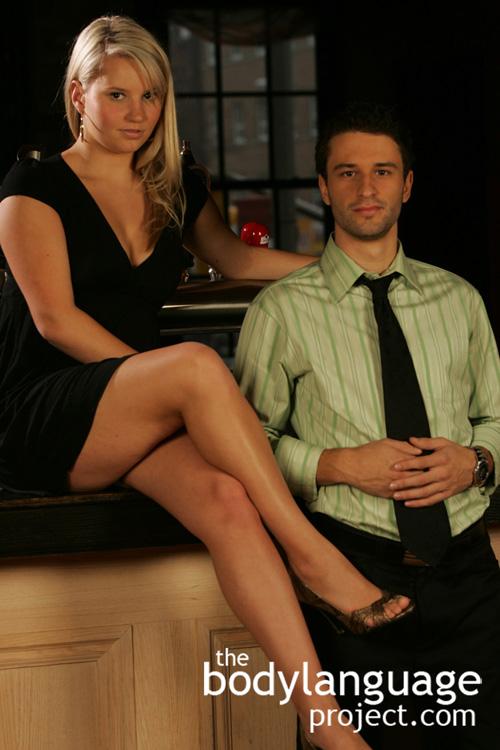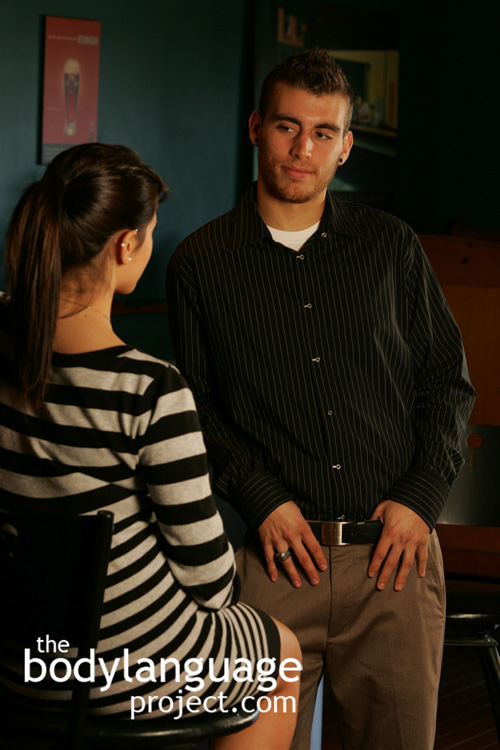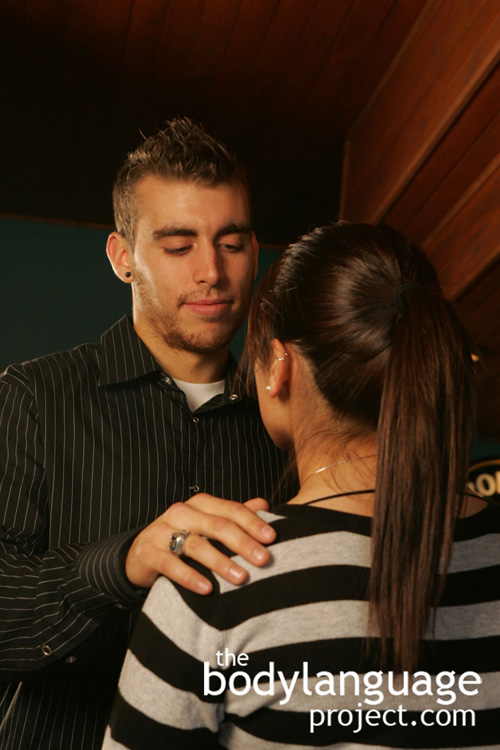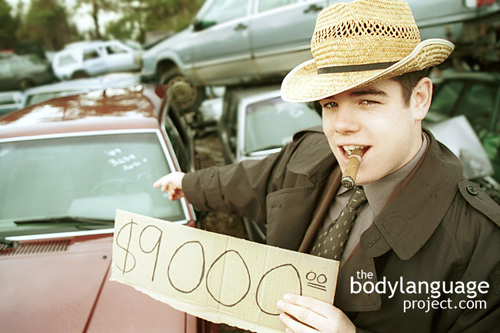The confusion men have when rating women’s nonverbal sexual signals probably has everything to do with the fact that men have twenty times more testosterone than women and so their perception of the world is viewed through ‘sex-coloured-glasses’. In terms of evolution and efficacy of spreading their seed, this makes sense, even though at times it can lead to unwanted or embarrassing confusion. Because of men’s inability to read cues properly, this chapter is heavily aimed identifying cues that will help men read the signals more precisely. The subtext of the chapter though, is aimed squarely on women to turn them into better deliverers of their true intent so as to avoid unwanted solicitation. In other words, women carry a clear fifty percent share of the fault when it comes to poor courtship cues, as are men in reading them. If women can improve the clearness of their signals, men can, and will respond more appropriately. When it comes to men, a precise, direct signal is best.
Tag Archive for Perception
The Chameleon Effect (Mimicry)
by Chris Site Author • March 6, 2013 • 0 Comments
A term first coined by Chartrand and Bargh in 1999, the “chameleon effect” refers to the unconscious mimicry of postures, mannerisms, facial expressions, and other behaviours such that one partner in an interaction passively and unintentionally changes his body positions to match that of others. He further describes that this changes are context specific and person specific. There are some key points in this idea. First is that the mirroring happens without conscious awareness, which will become important later as we explore the applications of mirroring. Second, a persons perception of another’s behaviour works to increase the likelihood of it appearing in others.
In other studies it was observed that nonverbal mirroring increased over time within a group of people. Rapport, liking, empathy and group building also increases over time. When students were asked to mirror the nonverbal language of their instructor they reported a stronger sense of involvement with them. It has even been reported that the absence of mirroring can even produce differences amongst people instead of just inhibiting cohesion.
The Cowboy Pose
by Chris Site Author • March 5, 2013 • 0 Comments
The cowboy pose happens by placing the thumbs in the belt loops with the remaining fingers pointed downwards towards the crotch. Popularized by old western movies cowboys would use a combination of this posture and the hands-on-hips (or gun) posture to show how macho they were. Because it draws attention once again to the crotch, it is rarely used by women. Women tend to have to use less aggressive, yet more sensual means to show off, such as thrusting their chest outward by rolling their shoulders back, or parting the legs slightly leaving them uncrossed. When amongst other men, the cowboy pose says that they are unafraid and can dominate. This posture is tolerable as a dominance display in men because it lacks the pompousness we can sometimes find coming from in-your-face displays. The cowboy pose is equal to the figure-four-leg cross with respect to perception by others and use acceptability. This not withstanding, the posture still needs to be used with caution.
The Shrinking Man
by Chris Site Author • March 5, 2013 • 0 Comments
Height plays a big role in how we are perceived and even the level of income we might reach. It has been noted that taller men are significantly more likely to earn higher salaries, and be promoted, then shorter men of similar experience and qualifications. This is because we attribute more favourable qualities to taller people, just like we do for attractive women. We can call this the “halo effect” because taller and more attractive people are treated like angels, even though there is no reason to believe that they are more deserving than anyone else. Unfortunately, this phenomenon also occurs in reverse. Shorter and less attractive people are thought to be less intelligent and lazy. Many research studies looking at the treatment differences of thin people versus those who are obese have shown that bystanders are significantly more likely to come to the assistance of the more attractive people over those who are overweight. Overweight people in distress are often outright ignored.
While the facts surrounding the halo effect might not come as a surprise, the fact that those in positions of power also receive more favourable ratings might. For example, bosses, professors, judges, and others in positions of authority are perceived to be taller than they really are. Shorter bosses are given a few extra inches and bosses that are the same height as an employee will be said to be taller than them. These ratings have everything to do with their relative importance. Because they are leaders, we give them leadership qualities. Therefore, height perception is due, in part, to the positions held by the people around us. Even those with quieter personalities will be perceived as shorter than they really are, and those with more assertive and authoritative attitudes will be perceived as taller.
Height is used as a means of establishing superior-subordinate relationships. These can be real as it is with short and tall people or circumstantial as in happens by modifying ones environment or posture. The judge is at a high bench for a reason, he is trying to reign over his courtroom and establish his importance. The same goes for King’s or the Pope whom take balcony vantage points to address their followers. The pharmacist on the other hand is a compete mystery!
Recognizing Body Affect By Culture
by Chris Site Author • March 5, 2013 • 0 Comments
In 1969 researchers Albert Mehrabian and John Friar found that a person’s state, their mood, and their emotional state were reflected by changes in body positions. In this context we are referring to affect in terms of simple gestures like leg crossing and arm crossing to indicate a closed mind or palms up and arms uncrossed to show openness or a willingness to listen. In fact, most of this book covers body affect and systematically breaks it down in future chapters. This cultural discussion is therefore important in that it describes the universality of body language.
While little research has focused specifically on measuring emotion from body positions, it has been found that the central nervous system is responsible for perception of emotion and this emotion is fed back into our body’s machinery to produce affect. The ways in which people convey emotion through body positions (or affect) is mediated by many factors including age, gender and context. Despite these factors though, body positions due to emotion, also has a cultural component. It is generally agreed that the face holds particularly universal expressions in terms of emotions as mentioned in the previous section, but the remaining language spoken by the body seems less obvious.
For example, the Japanese tend to be less expressive with their body language overall and therefore rate others more intensely on their nonverbal language. In a 2006 study by Andrea Kleinsmith and her colleagues out of London it was found that even mild expressions were rated as more emotional by the Japanese subjects over the ratings of other cultures on the same affect. A Westerner in the eye of the Japanese appears like a flailing uncontrolled windmill with their arms moving about as they gesticulate while they speak, whereas the Japanese appear rigid and uptight to a Westerner. In the study however, the meaning behind body language was still rated similarly across all cultures showing that emotion does have universal traits and crosses cultures. Thus, while the amount of affect does vary across cultures, the meaning behind the body language crosses boarders.
Summary – Chapter 2
by Chris Site Author • March 5, 2013 • 0 Comments
In this second chapter we have solidified our nonverbal foundation with the five cardinal rules of body language. First we covered the five basic rules of body language: the rule-of-four, congruence, context, baselining and intuition and perception. The ‘rule-of-four’ says that we need at least four independent, but related signals to reliably read someone whereas congruence says that we should pay particular attention when verbal language and nonverbal language do not match. Context on the other hand, says that we must be mindful of where and how cues develop since they could be confused with other variables and might mean something totally different or nothing at all. Baselining refers to the need to measure a person over time and in different situations before we can accurately predict their nonverbal meaning with any accuracy. The final rule says that we need to be conscious about intuition and perception so we don’t project meaning onto situations based on pre-conceived beliefs. We also covered how the feet are the most honest part of the body, and that coupled with putting presidency on negative body language over positive body language, we will have a greater success rate in reading people accurately.
Aside from these rules we looked at the flow of silent speech, how body language can be less confusing than verbal language, the differences between men and women, how women intuitively read body language and how age affects body language. We also discussed the importance that alpha’s, or leaders play in our lives and how we are either creating social norms (leading) or we are following them, how posture portrays confidence, the importance of ‘haptics’ or touch, in addition to body language as it relates to energy displacement and finally the meaning of fashion and preening.
Intuition Versus Perception In Body Language: Seeing What We Want To See
by Chris Site Author • March 5, 2013 • 1 Comment
Research by Harvard Robert Rosenthal conducted in the 1960s showed how people see what they want to see, instead of what’s really happening. In his study, he had set up two groups of students with a maze constructed for their subjects – rats. One group of students were told that their rats where “dumb” and the other group was told that their rates were “smart”, specifically bred to run mazes better then the other rats. While both sets of rats performed equally as well, the students with the preconceived notion that their rats where dumb catalogued behaviours supporting their initial impressions. The students with the “dumb” rats found that they were lethargic and dull. The rats of the group who thought they had smart rats documented how bright, alert and efficient the rats where as they made their way through the maze. Clearly from this study, our preconceived notions are potent and misleading. The same pitfalls can arise during the analysis of body language. If we truly wish to see nervous, emotional or confident body language, we will. But if we open our minds, we might see something completely different from what we initially expected to see.
Intuition includes the processing of information that we’ve obtained by observing people. When someone says they have a “bad” feeling about someone or they feel “uneasy” or the salesman was “slimy” they are using their intuition. Sometimes though, our intuition becomes clouded by preconceived notions and new information is tainted or distorted. This is when reading people can backfire to hurt us and others. When reading people it is important to clean the slate continuously and read each cue separately. While the rule of fours says we need to add cues together to discover the true meaning, using proper intuition without distortion, means we need to read each cue on their own. It means we need to avoid looking for hints we can use to support our conclusion, they are either there or aren’t there. In fact, the conclusion needs not play into the equation at all when reading but rather be a formulated after we have analyzed all the available information.
Many optical illusions or visual tricks rely on the fact that our brains are constructed to find information we think should be there, rather than looking at information that is actually there.
It’s easy to silence our intuition and ignore it since that little voice inside our heads is always trying to speak out and it’s only right some of the time. Let’s take poker again as an example. We found that baselining an individual can help in many ways most notably to help us reference behaviour, however, it would be disastrous to continue to call or raise someone who normally bluffs just because we have a strong hand, say a full house. In this situation, we are ignoring the current behaviour of the individual in favour of preconceived notions about them. As the hand plays out, we find that this bluffer continues to call even on our strongest bets, we find that sometimes they even raise or re-raise pushing the stakes even higher. Naturally, they’ve caught a rare hand, four of a kind, and easily crushing our full house. We’ve missed all the signals. The clues given all along were consistent with a strong position but we failed to read it correctly because we ignored all the rules. The information coming told use to read his moves at face value instead of modifying it to suite our needs, but at every step we ignored this. Our filters are important in simplifying information since it’s impossible to analyze everything going on around us, but we shouldn’t throw aside good information.
Having a good intuition is often not enough though. A “funny feeling” or “having a sense” or being “uneasy” about someone or something has merit, but if you can’t support your intuition with support such as postures and signals or in the case of poker “tells”, then we can’t graduate into a full reader of body language.
When we describe our intuition to others, we also need the proper vocabulary to convey our feelings to them. But this isn’t the only time we need to use the proper language of nonverbal reading, in fact, we need to train the little voice inside our head to also talk us through as we read others. When I watch someone, I can say unequivocally, that I think they are a timid, or confident or lack confidence and use specific examples. By the end of this book and with a little bit of practice, you will be able to do the same. As you learn, don’t be afraid to review the information in your head. Every mind is built differently, and I have a gift (when I’m actively listening) to remember verbal dialogue that has transpired years previous whilst recalling specific sentences used, the context and the location. Unfortunately for others, and sometimes fortunately for me, this has made me a very powerful debater. I can remain one hundred percent consistent in my position and use inconsistencies across the short or long term, to point out errors in reasoning of others. I can also cite specific instances that lead me to modified my position on things which can later help should I change my defense. Your mind might have more visual strengths, or analytical skills, or something else to help you dissect the cues of others. The point here is to use your strength in reading people rather then to focus on your weaknesses. Regardless however, do be aware of your flaws as it will make you a stronger reader overall.

She really liked me, she was really showing skin…or is she just sweating to death? It’s the sender that determines the intent of the message, not the body language reader.
Here are some final tips for reading via intuition. When in doubt, trust your gut as usually, but not always, it’s right and can be your saviour when we can’t pinpoint specific cues. Switch your mind back on and be more than just a casual observer of your environment. In the Sherlock Holmes book, A Scandal in Bohemia, Holmes tells Watson that he knows there are seventeen steps leading up to Baker Street. Watson was impressed by his observations, but it didn’t happen through magic, it was not more than simple observation. While Watson had merely seen the steps, Holmes had actively observed them. In a study by Simons and Chabris in 1999 out of Harvard University, Cambridge it was shown just how poor people are as observers of their surroundings. In the study a man walked in front of a group of students dressed in a gorilla suit while other activities took place around them. Half of the students hadn’t even noticed the “gorilla in their midst” which aptly formed part of the title to the study! It just goes to show that passive watching and active observing are two very different things, and this is what will separate average body language readers that cover the material like anyone else, even recall it, but two weeks later, become half as effective or worse, from those who build on their skills daily on their way to mastery. Active observation is a key ingredient to reading people and it can’t be done walking around blindfolded, however, even with a keen eye there will still be signals that go unnoticed as body language is fluid, ever changing and sometimes never repeating, meaning you only get one shot to catch a signal before it’s gone forever. Life is rich in detail and complex, we’d be fools to think we could read everything, but even with minimal effort, we can still impress others, and even ourselves, with how much can be read.
Remember too that it is always your job to determine the true intent of the sender, whatever cues they give off. Once you’ve caught cues that you think matter, remember that it is the sender of the message that determines it’s meaning, not the receiver.
This all sounds like a lot of work, but don’t worry, with practice your mind essential shifts back into autopilot and the process happens naturally. With time and practice, your subconscious will pick up and interpret skills all by itself without requiring active thought.
What Does It Mean To Read People?
by Chris Site Author • March 5, 2013 • 0 Comments
Reading people involves connecting all their signals, both verbal and nonverbal, throwing out the junk and connecting the rest to create meaning. The full story can only be told when all or most the factors about your target are connected. Research has shown that it is far easier to get away with a written lie over one told over the phone. From those facts you might guess that telling a lie in person is the hardest. Each additional communication channel that is added gives us more clues as to what is really going on.
You are missing the rest of the article! There is more content to read: Click to Register and Get Free Access To Read ALL Of This Content
If we could adding information, such as a person’s heart rate and sweat gland activity which is the primary channels using in lie detector machines we could be even more accurate. Therefore, just using one channel, and ignoring others, won’t allow us to do our jobs as accurately as using all the available channels.When we say that a person is “perceptive” what we really mean is that they are able to read the contradictions between what someone is saying and their body language. For example, someone might fidget, avoid eye contact and touch their nose but still be delivering a true statement. The reason is that, at times, these conflicting signals come from ambivalence, or outright uncertainty. Other times body language leaks through fatigue or other anomalous stimuli. The expert body language reader will intuitively understand the roots of nonverbal signals primarily by examining people through context and then relate the body language seen to actual meaning. For example, a good body language reader will properly connect fidgeting, tapping toes, and scratching the side of the nose with being tired, which is the right conclusion, rather than lying, one that is fabricated, because they will note the right circumstances surrounding the nonverbal language.
[/dw-post-more ]
To accurately read body language we need to connect the perception we have of the situation with the body language present, then use context, coupled with our know history of the person we are reading (i.e. their disposition and habits, or their “baseline”) to determine what is really going on. Advanced reading of body language is not simple, the process happens quickly and continuously.







